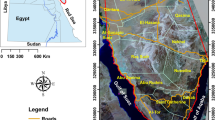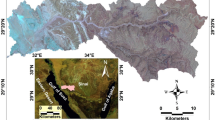Abstract
This study addressed potential areas for flood spreading by evaluating the Boolean Logic, Overlay Index and Fuzzy Clustering techniques for spatial analysis. We applied these techniques on the artificial recharge criteria of slope, infiltration rate, alluvium thickness, land use and alluvial quality. The above criteria were prepared, classified, weighted and integrated in a GIS environment. The resultant maps were organized into two classes of potentiality, suitable and unsuitable, which expressed two different levels of favorability for site selection of flood spreading in the study area. We used 32 controlling areas to compare the performance of these spatial analysis techniques. By validation of the produced maps, the most suitable areas of flood spreading for each technique were determined: Fuzzy Clustering (14.4 %) Overlay Index (10.84 %) and Boolean Logic (10 %). After land use filtering, 72 %, 70 % and 65 % of the most suitable areas were eliminated in the, Overlay Index, Boolean model and Fuzzy Clustering, respectively. According to our results, the spatial analysis techniques can be powerful tools for selecting the most suitable areas for flood spreading.











Similar content being viewed by others

References
Alesheikh AA, Soltani MJ, Nouri N, Khalilzadeh M (2008) Land assessment for flood spreading site selection using geospatial information system. Int J Environ Sci Tech 5(4):455–462
Asano T (1985) Artificial recharge of groundwater. Butterworth Publishers, United States of America, p.767
ASCE Standard (2001) Standard guidelines for artificial recharge of groundwater. Environmental and Water Resources Institute, American Society of Civil Engineers. ASCE standards, EWRI/ASCE 34–01, 106
Bezdek JC (1981a) Detection and characterization of cluster substracture. I. Linear structure: fuzzy c-lines. SIAM J Appl Math 40(2):339–357
Bezdek JC (1981b) Detection and characterization of cluster substracture. II. Fuzzy c-varieties and convex combinations thereof. SIAM J Appl Math 40(2):358–372
Bonham Carter G (1991) Geographic information system for geoscientists: modeling with GIS. Pergamon, Ontario, pp 319–470
Bonham Carter GF (1994) Geographic information systems for geoscientists: modeling with GIS. Paragon Press, Oxford
Bonham Carter G (1996) Geographic information systems for geoscientists modeling with GIS. Computer methods in the geosciences. Pergamon, Love Printing Service Ltd., Ontario, Canada, p 398
Cannon R, Dave J, Bezdek J (1986) Efficient implementation of the fuzzy c-means clustering algorithm. IEEE Trans Pattern Anal Mach Intell 8:248–255
FAO Soil Bulletin (1979) Soil Survey Investigations for Irrigation. FAO No. 42
Faucette B, King W, Germishuizen P (2003) Compost based erosion and sediment control demonstrations. BioCycle 44(10):32–40
Gass T (1979) Artificial recharge: part II. Water Well J 33:32–33
Ghayoumian J, Shoaei Z, Karimnejad HR, Ghermezcheshmeh B, Abdi P (2002) Some examples of artificial recharge of aquifers by floodwater spreading in Iran. Proceedings of the 9th Congress of the International Association for Engineering Geology and the Environment, Durban, South Africa 1529–1537
Ghayoumian J, Ghermezcheshme B, Feiznia S, Noroozi AA (2005) Integrating GIS and DSS for identification of suitable areas for artificial recharge, case study Meimeh Basin, Isfahan, Iran. Environ Geo 47(4):493–500
Ghayoumian J, Mohseni Saravi M, Feiznia S (2007) Application of GIS techniques to determine areas most suitable for artificial groundwater recharge in a coastal aquifer in southern Iran. J Asian Earth Sci 30:364–374
Gustafson DK (1979) Fuzzy clustering with a fuzzy covariance matrix. San Diego, USA, Proc. IEEE CDC
Han Z (2003) Groundwater resources protection and aquifer recovery in China. Environ Geol 44(1):106–111
Huang J, Zhang J (2011) Fuzzy C-means clustering algorithm with spatial constraints for distributed WSN data stream. Int J Adv Comput Technol III:165–175
Karaboga D, Ozturk C (2010) Fuzzy clustering with artificial bee colony algorithm. Sci Res Essays 5(14):1899–1902
Kheirkhak Zarkesh M (2005) Decision support system for floodwater spreading site selection in Iran. Wageningen University, Netherlands: International Institute for Geo-information Science and Earth Observation, Enschede, The Netherlands, 259 p
Krishnamurthy JS (1995) Role of geological and geomorphological factors in groundwater exploration: a study using IRS LISS data. Int J Remote Sens 16(14):2595–2618
Krishnamurthy J, Venkatesa Kumar N, Jayaraman M (1996) An approach to demarcate groundwater potential zones through remote sensing and geographical information system. Int J Remote Sens 17(10):1867–1884
Krishnapuram RK (1999) A note on the Gustafson-Kessel and adaptive fuzzy clustering algorithms. IEEE Trans Fuzzy Syst 7(4):453–461
Liu CW, Chen SK, Kuo SF (2001) Estimation of the infiltration rate of a paddy field inYen-Lin, Taiwan. Agr Syst 68(1):41–54
Murray JO, McDaniel PA (2003) Development of a GIS database for ground-water recharge assessment of the Palo use. Soil Sci 168(11):759–768
O'Hare MP, Fairchild DM, Hajali PA (1986) Artificial recharge of ground water. Lewis Publishers, Inc, Norman
Pal N, Bezdek J (1995) On cluster validity for fuzzy c-means model. IEEE Trans Fuzzy Syst 3:370–379
Raghonath K (1987) Groundwater assessment, development and management. McGraw-Hill Publishing Company Limited, 720 p
Ravi Shankar MN, Mohan G (2005) A GIS based hydrogeomorphic approach for identificationof site-specific artificial-recharge techniques in the Deccan Volcanic Province. J Earth Syst Sci, pp 505–514
Saade JJ, Diab HB (2004) Defuzzification methods and new techniques for fuzzy controller. Iran J Electr Comput Eng, 3(2):161–174
Saraf AC (1998) Integrated remote sensing and GIS for groundwater exploration and identification of artificial recharge sites. Int J Remote Sens 19(10):2595–2616
Saravi MM, Nouri B (2006) Identification of suitable sites for groundwater recharge. The 2nd International Conference on Water Resources and Arid Environment, 1–5
Schabenberger O, Gotway CA (2005) Statistical methods for spatial data analysis. Chapman and Hall/CRC Press, p 512
Sukumar S, Sankar K (2010) Delineation of potential zones for artificial recharge using GIS in Theni district, Tamilnadu, India. International Journal of Geomatics and Geoscience, pp 639–648
Tabari H, Talaee HP (2011) Temporal variability of precipitation over Iran. Int J Hydrol 396:313–320
Technical report for artificial recharge through flood spreading in I. R. Iran (1999) Soil Conservation and Watershed Management Research Institute
Tiederman W, Kincannon O (1972) Water reclamation for ground water recharge. Oklahoma Water Resources Research Institute, Oklahoma State University. Stillwater, Oklahoma: OWRR-A-034-OKLA(1)
Wood WW (1980) Developement of technical site selection criteria for artificial recharge. Wastewater reuse for groundwater recharge. Proceedings of the Symposium, Pomona, California, 73–97
Wu KY (2002) Alternating c-means clustering algorithms. Pattern Recogn 35:2267–2287
Wu K, Yang M (2005) A cluster validity index for fuzzy clustering. Pattern Recogn Lett, pp 1275–1291
Yu J, Cheng Q, Huang H (2004) Analysis of the weighting exponent in the FCM. IEEE Trans Systems Man Cybernet, pp 634–639
Zehtabian GA (2001) Determination of an appropriate area for flood water spreading by remote sensing data and GIS. In: Proceedings of the International Conference on New Technology for a New Century, Seoul, Korea. p1–6
Author information
Authors and Affiliations
Corresponding author
Rights and permissions
About this article
Cite this article
Moradi Dashtpagerdi, M., Nohegar, A., Vagharfard, H. et al. Application of Spatial Analysis Techniques to Select the Most Suitable Areas for Flood Spreading. Water Resour Manage 27, 3071–3084 (2013). https://doi.org/10.1007/s11269-013-0333-0
Received:
Accepted:
Published:
Issue Date:
DOI: https://doi.org/10.1007/s11269-013-0333-0



